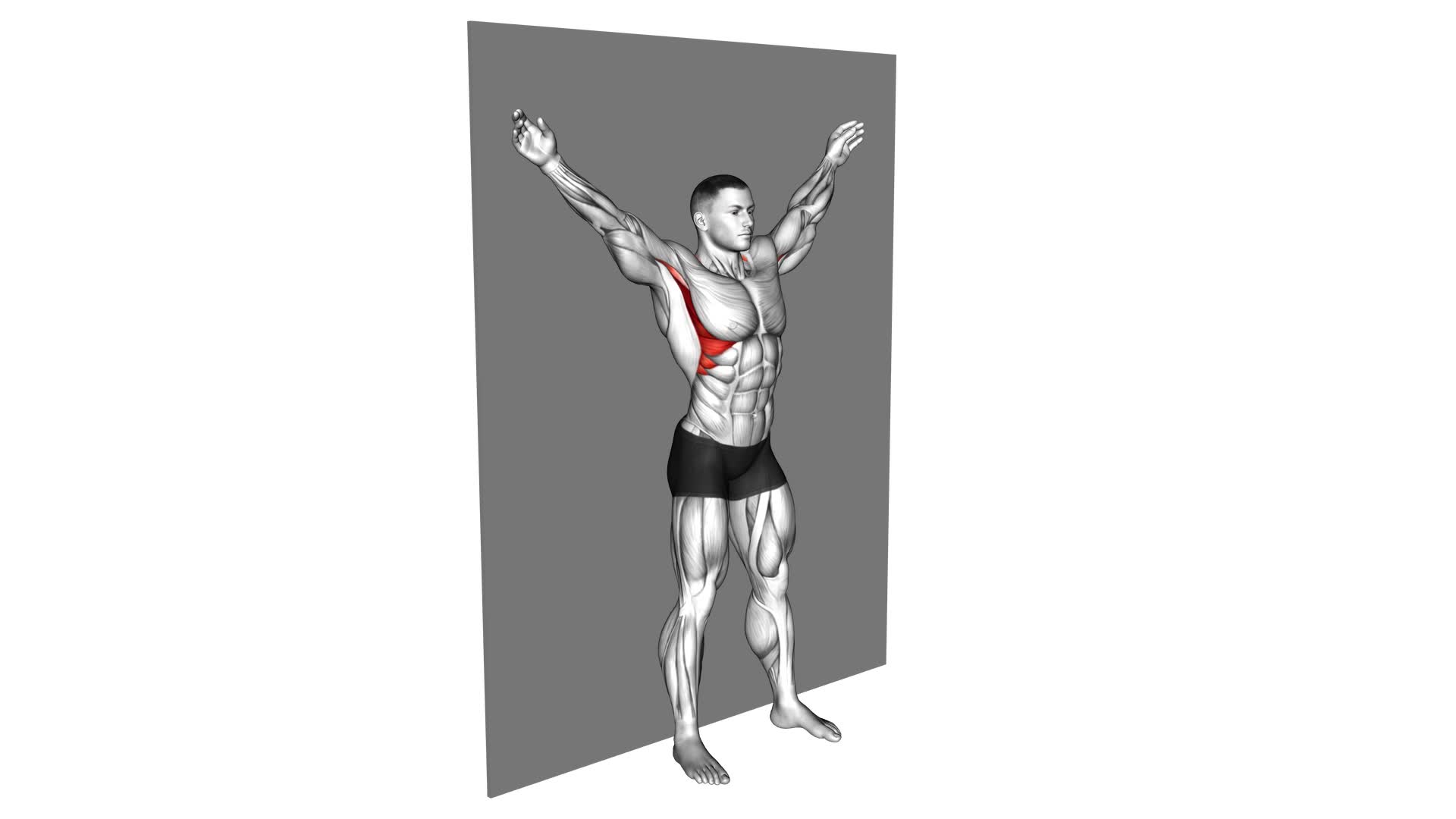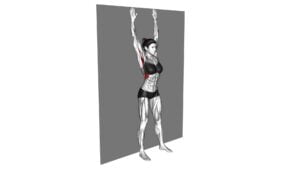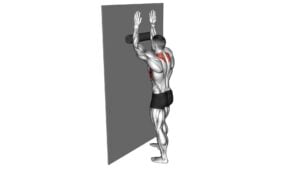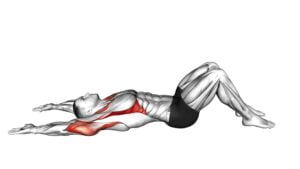Scapular Slide Back to Wall – Video Exercise Guide & Tips

Looking to improve your scapular stability and strengthen your upper back muscles? The scapular slide back to wall exercise is just what you need!
Watch This Exercise Video
In this video exercise guide, we'll show you the proper technique for performing this effective exercise.
You'll also learn common mistakes to avoid and tips to maximize its effectiveness.
Whether you're a beginner or advanced, this exercise can be tailored to your fitness level.
So grab a wall and get ready to slide those scapulas back!
Key Takeaways
- Improved posture and shoulder stability
- Targets muscles responsible for stabilizing shoulder blades
- Reduces the risk of injuries
- Focuses on postural correction and alignment
Benefits of Scapular Slide Back to Wall
You will experience improved posture and shoulder stability when performing the Scapular Slide Back to Wall exercise. This exercise specifically targets the muscles responsible for stabilizing your shoulder blades, also known as the scapulae. By strengthening these muscles, you can enhance your overall shoulder stability and reduce the risk of injuries.
Maintaining good shoulder stability is crucial for proper posture. When your scapulae are weak or unstable, it can result in rounded shoulders and a forward head posture. This not only affects your appearance but also puts unnecessary strain on your neck, upper back, and shoulders. By regularly incorporating the Scapular Slide Back to Wall exercise into your fitness routine, you can counteract these postural imbalances and improve your overall alignment.
The Scapular Slide Back to Wall exercise is particularly effective because it targets the muscles that retract and depress your shoulder blades. Retraction refers to squeezing your shoulder blades together, while depression involves pulling them down towards your lower back. Strengthening these actions won't only improve your posture but also enhance your shoulder stability during everyday activities and exercise.
Equipment Needed for Scapular Slide Back to Wall
To perform the Scapular Slide Back to Wall exercise, you'll need some essential equipment. The main equipment you'll need is a wall or a sturdy vertical surface to lean against. This will provide the support and stability necessary for proper execution of the exercise.
Alternatively, if you don't have access to a wall, you can use a resistance band or a suspension trainer to mimic the movement and achieve similar benefits.
Essential Equipment for Scapular Slide
To perform the Scapular Slide Back to Wall exercise, you'll need some essential equipment. The good news is that this exercise requires minimal equipment, making it accessible to most people.
All you need is a wall and a flat surface to stand on. Find a wall that's free of obstacles and has enough space for you to comfortably stand with your back against it. Make sure the surface you're standing on is stable and non-slippery to ensure your safety during the exercise.
With these simple equipment requirements, you can easily perform the Scapular Slide Back to Wall exercise and reap its benefits for your upper body strength and posture.
Alternatives to Required Equipment
There are several alternatives for the equipment needed to perform the Scapular Slide Back to Wall exercise. If you don't have access to a wall, here are some alternative exercises you can try:
- Resistance band rows: Attach a resistance band to a sturdy object, such as a doorknob or a railing, and perform rows by pulling the band towards your body while keeping your shoulder blades engaged.
- TRX rows: If you have access to TRX straps or suspension trainers, you can perform rows by adjusting the straps to an appropriate height and pulling your body towards the straps while keeping your shoulder blades squeezed.
Modifications and adaptations can also be made to the Scapular Slide Back to Wall exercise itself. For example, if you have difficulty performing the exercise standing up, you can try doing it in a seated or kneeling position. Remember to maintain proper form and engage your shoulder blades throughout the movement.
Proper Technique for Scapular Slide Back to Wall
To perform the Scapular Slide Back to Wall exercise with proper technique, it's important to focus on shoulder blade alignment. Use the wall as a reference point to ensure your shoulder blades are touching the wall throughout the movement.
Avoid common mistakes such as shrugging your shoulders or arching your lower back, as these can compromise the effectiveness of the exercise.
Shoulder Blade Alignment
Achieve optimal shoulder blade alignment by performing the Scapular Slide Back to Wall exercise with proper technique. This exercise is excellent for improving shoulder blade mobility and scapular stability.
To ensure you're performing the exercise correctly, follow these tips:
- Stand with your back against a wall, making sure your feet are about six inches away from the wall.
- Place your hands on the wall at shoulder height with your elbows bent at 90 degrees.
- Slide your shoulder blades down and back towards the wall, maintaining contact with the wall throughout the movement.
- Keep your core engaged and your neck relaxed.
- Slowly slide your arms up and down the wall, focusing on maintaining proper shoulder blade alignment.
Wall as Reference Point
Stand with your back against the wall to use it as a reference point for proper technique during the Scapular Slide Back to Wall exercise. Wall positioning is crucial in ensuring correct form and maximizing the benefits of this exercise.
By standing with your back against the wall, you create a stable base and maintain proper alignment throughout the movement. This reference point allows you to monitor your scapular movement and ensure that your shoulder blades are sliding smoothly along the wall. It also helps you maintain an upright posture and prevents any excessive forward or backward lean.
Correct form is essential for targeting the muscles effectively and avoiding any potential injuries. So, make sure to position yourself correctly against the wall to maintain proper technique and get the most out of your Scapular Slide Back to Wall exercise.
Common Mistakes to Avoid
One common mistake to avoid when performing the Scapular Slide Back to Wall exercise isn't maintaining proper alignment. It's crucial to pay attention to your shoulder positioning to ensure muscle activation and prevent injury.
Here are two key points to remember:
- Keep your shoulders relaxed and away from your ears. Avoid shrugging or tensing your shoulder muscles.
- Engage your scapular muscles by actively pulling your shoulder blades down and back towards your spine.
Maintaining proper shoulder positioning and activating the correct muscles during the Scapular Slide Back to Wall exercise is essential for maximizing its benefits and minimizing the risk of strain or discomfort. By focusing on alignment and muscle activation, you can effectively strengthen your upper back and improve posture.
Common Mistakes to Avoid During Scapular Slide Back to Wall
To prevent common mistakes during the Scapular Slide Back to Wall exercise, make sure to maintain proper form and avoid these errors.
This exercise is great for improving shoulder stability and scapular mobility.
One common mistake to avoid is rounding your upper back. It's important to keep your spine straight and maintain a neutral position throughout the movement.
Another mistake is allowing your shoulders to shrug or hunch up towards your ears. Instead, focus on keeping your shoulders down and relaxed.
Additionally, be mindful of your head position. Avoid tucking your chin or looking down, as this can strain your neck. Keep your gaze forward and your chin parallel to the ground.
Lastly, don't rush through the exercise. Take your time and perform each repetition with control and intention.
Tips to Maximize the Effectiveness of Scapular Slide Back to Wall
To maximize the effectiveness of the Scapular Slide Back to Wall exercise, focus on maintaining proper form and incorporating these tips:
- Engage your shoulder stability: Throughout the exercise, keep your shoulder blades pulled down and back. This will help activate the muscles responsible for stabilizing the shoulders, promoting better posture and reducing the risk of injury.
- Focus on postural correction: Use the exercise as an opportunity to correct any postural imbalances. Pay attention to your alignment and make sure your head, shoulders, and hips are in proper alignment. This will help improve your overall posture and prevent any undue stress on your spine.
By following these tips, you can ensure that you're maximizing the effectiveness of the Scapular Slide Back to Wall exercise. Remember to prioritize shoulder stability and postural correction for optimal results.
Transitioning into the subsequent section about 'variations and progressions for scapular slide back to wall', you can continue to challenge yourself and further enhance your shoulder stability and postural correction by exploring different variations and progressions of this exercise.
Variations and Progressions for Scapular Slide Back to Wall
Explore different ways to challenge yourself and enhance your shoulder stability and postural correction with variations and progressions of the Scapular Slide Back to Wall exercise. By incorporating different variations into your workout routine, you can target specific muscles and increase the difficulty level of the exercise.
One variation is the Scapular Slide Back to Wall with a resistance band. Attach a resistance band to a sturdy anchor point and hold the other end in your hands. As you perform the exercise, the resistance from the band will add an extra challenge to your shoulder muscles.
Another variation is the Single Leg Scapular Slide Back to Wall. Instead of standing with both feet, balance on one leg while performing the exercise. This variation not only strengthens your shoulder muscles but also challenges your balance and stability.
To progress the exercise further, you can try the Scapular Slide Back to Wall with a weighted vest. By adding extra weight to your body, you increase the resistance and intensity of the exercise, leading to greater muscle activation and strength gains.
Remember to always start with the basic Scapular Slide Back to Wall exercise and gradually progress to more challenging variations. This will ensure that you have a strong foundation and minimize the risk of injury.
Frequently Asked Questions
How Many Repetitions Should I Do for the Scapular Slide Back to Wall Exercise?
To determine how many repetitions of the scapular slide back to wall exercise you should do, it's important to consider your fitness level and goals. The number of sets and repetitions can vary. However, the general recommendation is to start with 2-3 sets of 10-15 repetitions.
Gradually increase the intensity and volume as you become more comfortable and stronger.
This exercise helps improve posture, strengthen the upper back muscles, and promote shoulder stability.
Can I Perform the Scapular Slide Back to Wall Exercise if I Have a Shoulder Injury?
If you have a shoulder injury, there are modifications you can make to the scapular slide back to wall exercise. You might try using a smaller range of motion or reducing the intensity.
However, it's always best to consult with a healthcare professional or physical therapist for personalized advice.
If the scapular slide back to wall exercise isn't suitable for your shoulder injury, there are alternative exercises you can do to strengthen your upper back and improve shoulder stability.
Is It Normal to Feel a Burning Sensation in the Muscles During the Scapular Slide Back to Wall Exercise?
Feeling a burning sensation in your muscles during the scapular slide back to wall exercise is normal. It indicates that your muscles are actively engaged and working hard.
This exercise targets your shoulder and back muscles, which can cause the burning sensation as they're being challenged.
It's important to listen to your body and stop if the burning sensation becomes too intense or if you feel any sharp pain.
How Often Should I Include the Scapular Slide Back to Wall Exercise in My Workout Routine?
Including the scapular slide back to wall exercise in your workout routine can offer numerous benefits. It helps improve scapular stability, strengthens the muscles of the upper back and shoulders, and promotes proper posture.
The exercise can be done 2-3 times per week, depending on your fitness level and goals. It's important to vary the exercise by adding different variations, such as using resistance bands or performing it on an unstable surface, to challenge your muscles and maximize the benefits.
Can I Perform the Scapular Slide Back to Wall Exercise Without a Wall?
Yes, you can perform the scapular slide back to wall exercise without a wall. If you don't have access to a wall, there are alternatives you can try.
One option is to perform the exercise standing in front of a sturdy surface, like a countertop.
Another option is to use a resistance band to mimic the movement.
The benefits of this exercise include improving posture, strengthening the muscles of the upper back, and reducing the risk of shoulder injuries.
Conclusion
In conclusion, the Scapular Slide Back to Wall exercise is a beneficial movement for improving scapular stability and posture. By engaging the muscles of the upper back and shoulders, this exercise helps to correct imbalances and strengthen the muscles responsible for proper shoulder alignment.
To maximize effectiveness, it's important to maintain proper technique and avoid common mistakes.
With variations and progressions, individuals can continue to challenge themselves and further improve their scapular strength and stability.

Author
Years ago, the spark of my life’s passion ignited in my mind the moment I stepped into the local gym for the first time. The inaugural bead of perspiration, the initial endeavor, the very first surge of endorphins, and a sense of pride that washed over me post-workout marked the beginning of my deep-seated interest in strength sports, fitness, and sports nutrition. This very curiosity blossomed rapidly into a profound fascination, propelling me to earn a Master’s degree in Physical Education from the Academy of Physical Education in Krakow, followed by a Sports Manager diploma from the Jagiellonian University. My journey of growth led me to gain more specialized qualifications, such as being a certified personal trainer with a focus on sports dietetics, a lifeguard, and an instructor for wellness and corrective gymnastics. Theoretical knowledge paired seamlessly with practical experience, reinforcing my belief that the transformation of individuals under my guidance was also a reflection of my personal growth. This belief holds true even today. Each day, I strive to push the boundaries and explore new realms. These realms gently elevate me to greater heights. The unique combination of passion for my field and the continuous quest for growth fuels my drive to break new ground.







